Welcome to our Master Doberman Pinscher Training Guide, where we will provide you with proven techniques to train your Doberman for success. As a unique breed, Doberman Pinschers require specialized training methods to unlock their full potential. Our comprehensive guide is designed to help you navigate the training journey, ensuring a happy and well-behaved companion.
- Training Doberman Pinschers requires specific techniques tailored to their breed characteristics.
- Obedience training and behavior training are essential for a well-behaved and happy Doberman.
- Start training your Doberman Pinscher from a young age to establish good habits.
- Positive reinforcement methods and consistency are key in Doberman training.
- Consider socialization and mental stimulation to keep your Doberman mentally and physically engaged.
Understanding the Doberman Pinscher Breed
Before diving into the training techniques, it is essential to understand the special attributes of Doberman Pinschers that make them distinct from other breeds. Doberman Pinschers are known for their intelligence, loyalty, and protective nature. They are highly energetic dogs that require mental and physical stimulation to thrive. This breed is known for its muscular build and sleek coat, which comes in various colors including black, red, blue, and fawn.
Doberman Pinschers are renowned for their trainability, making them excellent candidates for obedience training. However, their intelligence can also make them headstrong and independent at times. This is why a professional Doberman Pinscher training guide is crucial in channeling their energy and teaching them essential commands and behaviors.
To be successful in training a Doberman Pinscher, it is important to establish a strong bond based on trust and respect. Positive reinforcement techniques, such as rewards and praise, work best with this breed. It is important to be consistent in your training methods and provide clear cues to guide their behavior. Using visual cues, such as hand signals, can be especially effective in communicating with Dobermans.
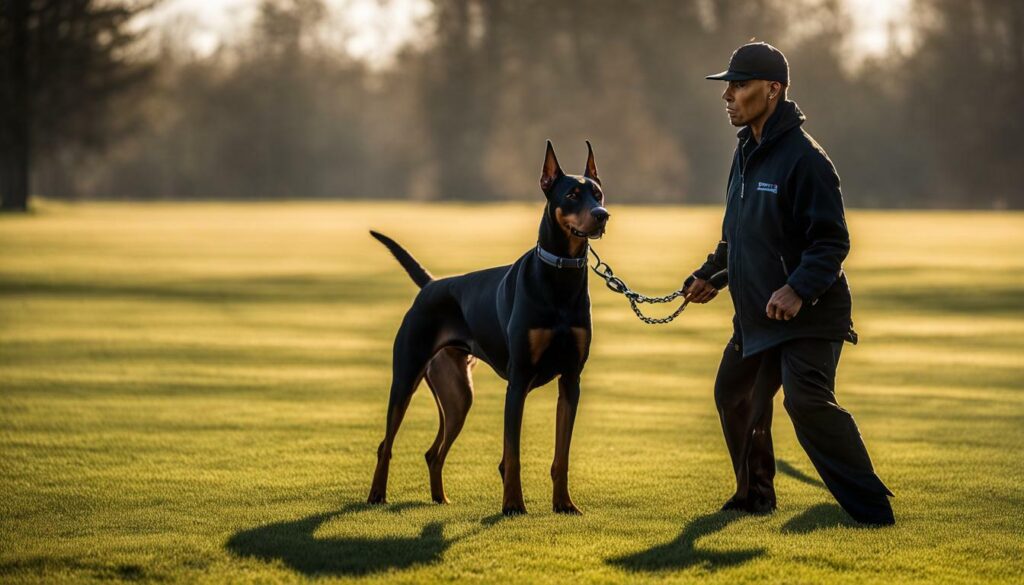
Now that we have a basic understanding of the Doberman Pinscher breed, we can move on to the specific training techniques tailored for them. The following sections will provide a comprehensive guide to help you train your Doberman Pinscher effectively and unlock their full potential.
Starting Off Right: Choosing the Right Doberman Pinscher
The foundation of successful Doberman Pinscher training begins with selecting the right breed companion that suits your lifestyle and training goals. Whether you are considering a Doberman Pinscher from a reputable breeder or a rescue organization, taking the time to find a puppy with the right temperament is crucial for training success.
When choosing a Doberman Pinscher, look for traits such as confidence, sociability, and eagerness to learn. These qualities will make the training process smoother and more enjoyable for both you and your new furry friend. A well-bred Doberman with a stable temperament will be more receptive to training and exhibit the desired qualities of a well-behaved dog.
Reputable breeders and rescue organizations can help guide you in selecting the right puppy based on your specific needs and preferences. They can provide valuable insights into the puppy’s lineage, health history, and temperament. It’s essential to ask questions and gather as much information as possible before making your decision.
Remember, choosing the right Doberman Pinscher is the first step in embarking on a successful training journey. By finding a suitable companion with the right temperament, you set the stage for a strong and trusting bond that will lay the groundwork for a well-behaved and happy Doberman Pinscher.
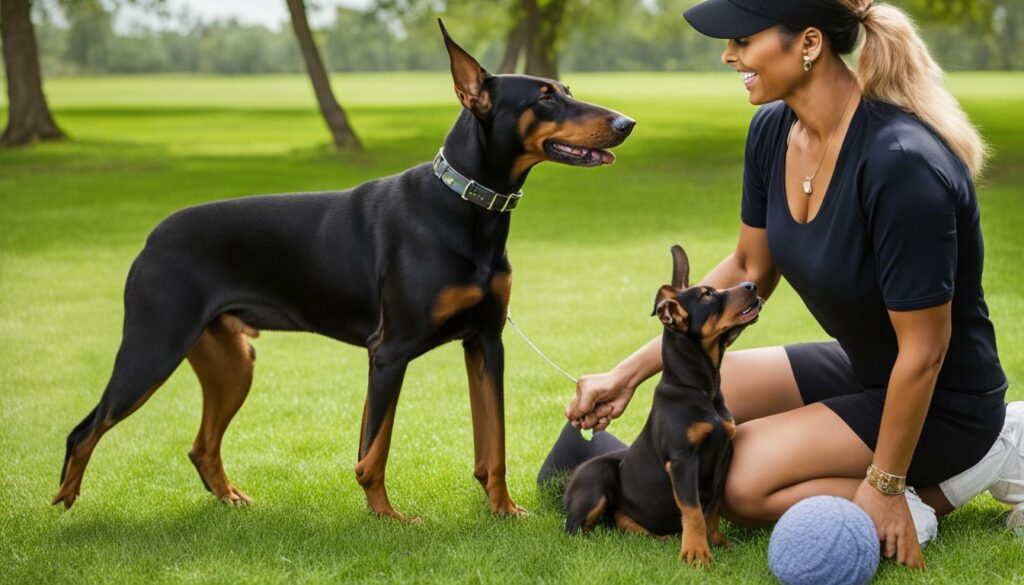
| Trait | Description |
|---|---|
| Confidence | A self-assured and confident Doberman is more likely to excel in training. |
| Sociability | A Doberman that is sociable and enjoys the company of people and other animals will be easier to socialize. |
| Eagerness to Learn | A Doberman with a natural curiosity and eagerness to learn will be more receptive to training. |
| Temperament | A well-balanced and stable temperament is essential for a well-behaved and trainable Doberman. |
By considering these characteristics and working with reputable sources, you can make an informed decision when choosing your Doberman Pinscher and set the stage for a successful training journey.
Early Training Stages: Building a Strong Foundation
In the early stages of your Doberman Pinscher’s life, it is crucial to establish a strong foundation through consistent training, beginning as early as 8 weeks old. Training techniques for Doberman Pinschers focus on creating a well-behaved and obedient pet, setting the stage for a lifetime of positive interactions and a deep bond between you and your furry companion.
Leash Training
One of the first training aspects to tackle is leash training. Introduce your Doberman Pinscher to a leash early on and guide them gently, rewarding them with treats for walking alongside you without pulling. Start with short walks and gradually increase the distance as your puppy becomes more comfortable.
Crate Training
Crate training is another crucial step in establishing a strong foundation. Introduce your Doberman Pinscher to their crate as a safe and comfortable space. Use positive reinforcement techniques, such as treats and praise, to encourage them to enter and stay in the crate. This will help with potty training and provide them with a secure place to rest when needed.
Potty Training
Potty training is an essential part of early training. Take your Doberman Pinscher outside frequently, especially after meals and naps, and reward them for eliminating in the appropriate spot. Use consistent commands and a positive tone to reinforce the desired behavior. Accidents may happen, but be patient and consistent in your training approach.
By focusing on these early training stages, you are building a solid foundation for your Doberman Pinscher’s future success. With patience, consistency, and positive reinforcement, you can raise a well-behaved and obedient pet who will bring joy and companionship to your life.
| Training Techniques for Doberman Pinschers: | Doberman Pinscher Obedience Training: |
|---|---|
| – Leash training | – Consistency in commands |
| – Crate training | – Positive reinforcement |
| – Potty training | – Patience and consistency |
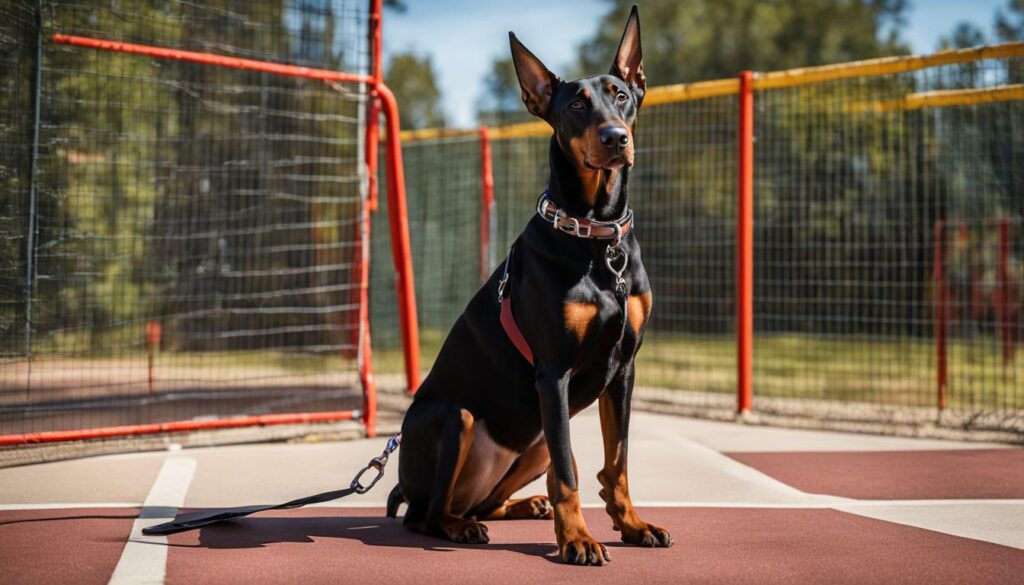
Establishing a strong foundation through early training stages is essential for your Doberman Pinscher’s development and overall well-being. By mastering techniques such as leash training, crate training, and potty training, you are setting the stage for a well-behaved and obedient dog. Remember to be consistent, patient, and use positive reinforcement to encourage desired behaviors. With time and effort, your Doberman Pinscher will grow into a happy and well-trained companion.
Developing Good Behavior: Obedience and Beyond
To ensure a well-behaved and disciplined Doberman Pinscher, behavior training goes beyond basic obedience and focuses on promoting positive habits and impulse control. The key to success lies in understanding the unique characteristics of Doberman Pinschers and using effective training methods tailored specifically to their needs.
One important aspect of behavior training is motivation. Dobermans are intelligent and thrive on mental stimulation. By using positive reinforcement techniques such as rewarding good behavior with treats or praise, you can motivate your Doberman to learn and obey commands eagerly. Visual cues, such as hand signals or specific gestures, can also reinforce obedience and establish a clear line of communication between you and your furry companion.
Consistency is another crucial factor in behavior training. Setting clear rules and boundaries from the start and being consistent in enforcing them will help your Doberman understand what is expected of them. This consistency should extend to all members of the household, ensuring a unified approach to training. By providing structure and routine, you can create a stable environment for your Doberman to thrive.
To further assist you in your behavior training journey, here is a table of contents highlighting various topics covered in the comprehensive Doberman Pinscher training guide:
| Section | Topics Covered |
|---|---|
| Section 1 | Introduction to the Doberman Pinscher training guide and its effectiveness |
| Section 2 | Understanding the breed characteristics and training requirements of Doberman Pinschers |
| Section 3 | Choosing the right Doberman Pinscher and tips for finding a reputable breeder or rescue |
| Section 4 | Early training stages, including leash training, crate training, and potty training |
| Section 5 | Developing good behavior through obedience training and impulse control |
| Section 6 | The importance of socialization and mental stimulation for a well-rounded Doberman |
| Section 7 | Advanced training techniques and exploring dog sports where Dobermans excel |
| Section 8 | Modern training methods and best practices for successful Doberman training |
| Section 9 | Troubleshooting common training challenges and overcoming them |
| Section 10 | A comprehensive overview of the Doberman Pinscher training guide |
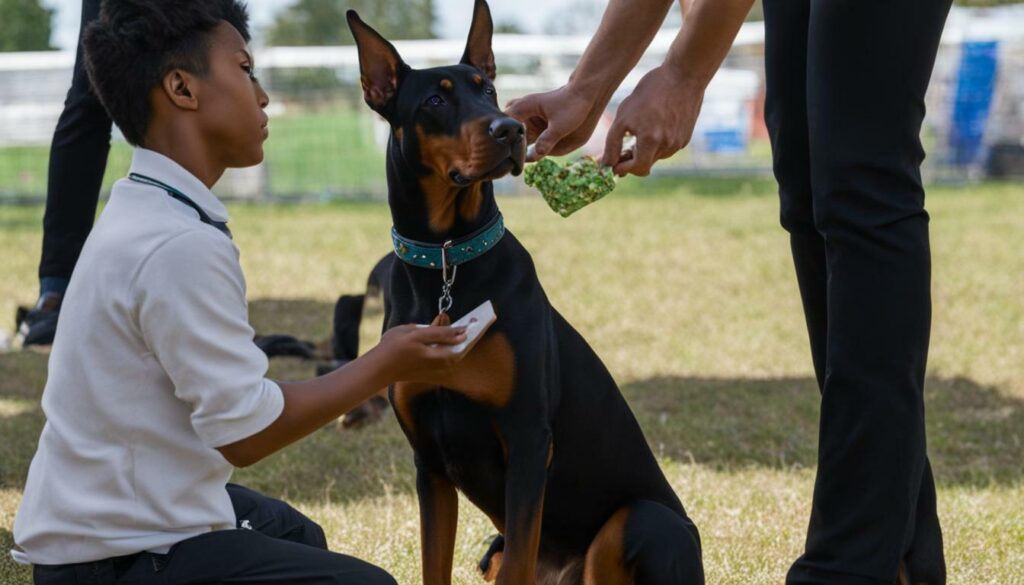
By following the comprehensive training guide, you can navigate the various aspects of Doberman Pinscher training, ensuring a well-behaved and happy companion. From adopting the right Doberman to addressing behavioral challenges, this guide covers all the essential elements of successful training. By investing time and effort into your Doberman’s training, you are setting them up for a lifetime of good behavior and a strong bond with their human family.
The Power of Socialization and Stimulation
Socialization and mental stimulation play a vital role in shaping a confident and well-adjusted Doberman Pinscher, and we’ll explore effective strategies to achieve this. As a highly intelligent and energetic breed, Dobermans thrive when provided with ample opportunities to interact with other dogs, people, and their environment. It not only helps prevent behavioral issues but also strengthens their ability to adapt to various situations.
A great way to socialize your Doberman is through controlled exposure to different environments, sounds, and experiences. This can include regular visits to dog parks, playdates with well-mannered dogs, and positive encounters with new people. Gradually introducing your Doberman to different stimuli, such as car rides, crowds, and various surfaces, will help them develop confidence and reduce anxiety.
Mental stimulation is equally important for keeping your Doberman engaged and preventing boredom-related behaviors. Engage them in interactive play sessions, provide puzzle toys, and consider enrolling them in obedience classes or dog sports. These activities not only challenge their intellect but also reinforce the bond between you and your Doberman.
Remember, each Doberman is unique, so be patient and adapt your socialization and stimulation strategies to their individual needs. With consistent training and exposure, you’ll be rewarded with a happy, well-rounded Doberman Pinscher who is a joy to have as a companion.
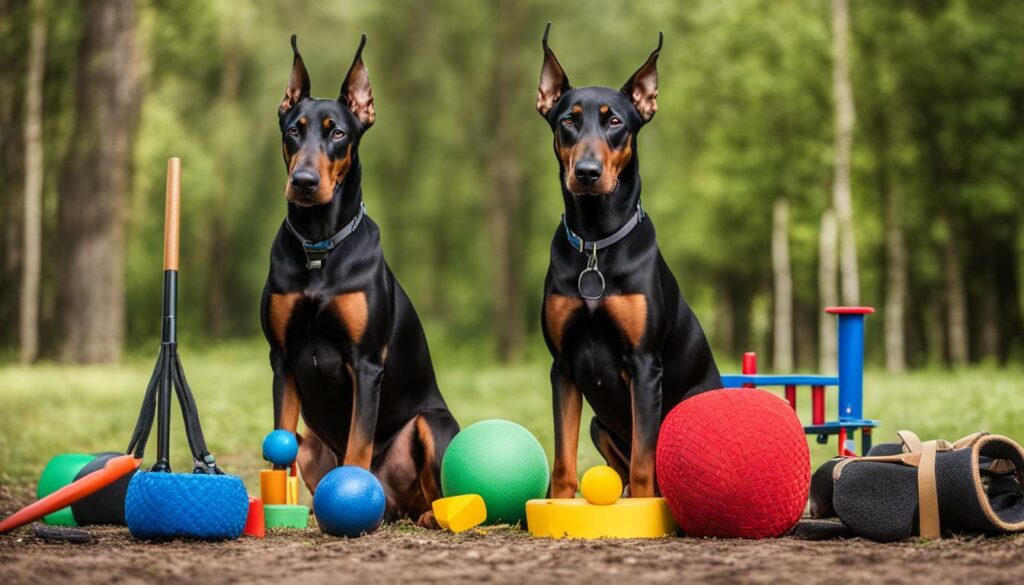
Table of Contents: Socialization and Stimulation
| Section | Topics Covered |
|---|---|
| 1 | Benefits of Socialization |
| 2 | Introducing Your Doberman to New Environments |
| 3 | Positive Exposure to Different Stimuli |
| 4 | Mental Stimulation Activities |
| 5 | Adapting Strategies to Your Doberman’s Needs |
Advanced Training: From Skills to Sports
Once your Doberman Pinscher has mastered the basics, it’s time to delve into advanced training techniques and discover exciting dog sports that will showcase their exceptional abilities. Building on the foundation of obedience and behavior training, advanced training takes your Doberman’s skills to the next level, both mentally and physically.
Achieving Off-Leash Control
Off-leash training is a crucial skill to develop for safety and freedom during walks and outdoor activities. Begin by practicing in a secure, enclosed area and gradually increase the distractions. Use positive reinforcement and rewards to encourage your Doberman to stay close and respond promptly to commands. Consistency and patience are key as your Doberman learns to remain focused and responsive even without a leash.
Exploring Dog Sports
Doberman Pinschers excel in various dog sports that provide mental and physical stimulation while harnessing their natural abilities. Consider trying agility, where your Doberman can navigate obstacle courses with speed and precision. Their athleticism and intelligence make them well-suited for obedience trials, where they showcase their responsiveness and precision. Additionally, tracking and scent work allow them to tap into their strong sense of smell and utilize their natural instincts.
| Sport | Description |
|---|---|
| Agility | A timed event where dogs navigate obstacles, demonstrating speed, agility, and accuracy. |
| Obedience Trials | Dogs perform a series of exercises demonstrating their obedience, precision, and responsiveness to commands. |
| Tracking and Scent Work | Utilizing their strong sense of smell, dogs track scents to find hidden objects or follow a designated trail. |
Participating in dog sports not only provides mental and physical stimulation but also strengthens the bond between you and your Doberman. It allows them to channel their energy and intelligence into rewarding activities that they truly enjoy.
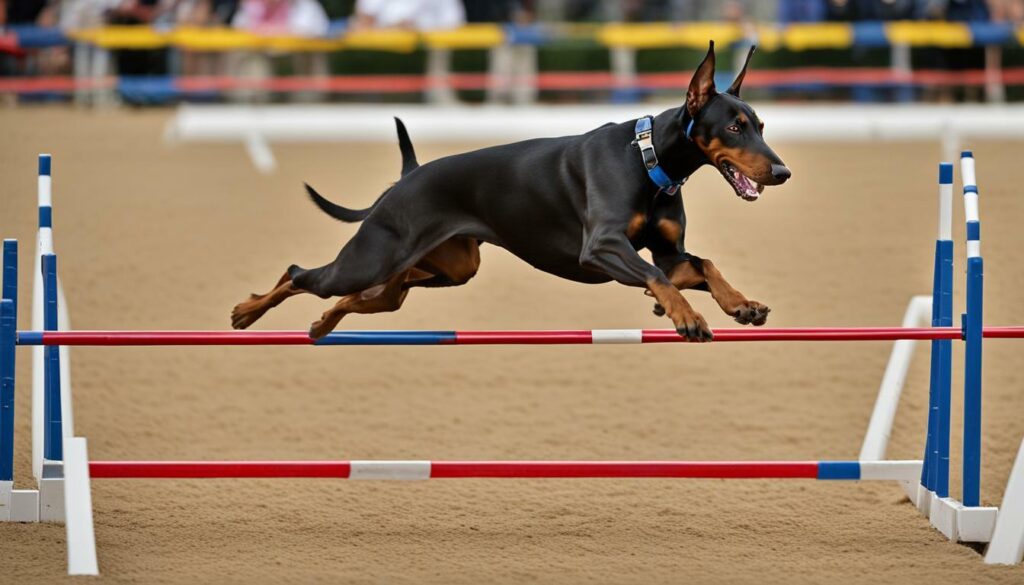
Remember, advanced training should always be approached with patience, positive reinforcement, and consideration for your Doberman’s abilities and limitations. With dedication and consistency, you can unlock the full potential of your Doberman Pinscher, creating a well-rounded and fulfilled companion.
Modern Training Methods and Best Practices
In today’s world, effective Doberman Pinscher training relies on modern methods that prioritize positive reinforcement and establish a strong bond between you and your furry companion. These methods have proven to be more successful than traditional dominance-based training, creating a positive and enjoyable experience for both you and your Doberman.
To ensure the best training outcomes, it is crucial to motivate your Doberman using rewards such as treats, praise, and playtime. Positive reinforcement encourages desired behaviors and helps your dog understand what is expected of them. Visual cues, such as hand signals and gestures, can also enhance communication and reinforce commands.
Consistency is key when it comes to training your Doberman. Establish clear rules and expectations from the start, and be consistent in rewarding good behavior and redirecting undesirable actions. This consistency helps your dog understand boundaries and builds their trust in you as their leader.
| Training Tools | Description |
|---|---|
| Clicker | A clicker can be a handy tool for marking desired behaviors and signaling to your Doberman that they have done something right. The sound of the clicker acts as a bridge between the behavior and the reward. |
| Treat Pouch | A treat pouch allows you to conveniently carry and access rewards during training sessions. It keeps treats easily accessible for timely reinforcement and keeps your hands free for training. |
| Training Leash | A training leash is an essential tool for teaching your Doberman to walk on a loose leash. It provides control during training walks and helps correct pulling or other leash-related issues. |
Socialization and Starting Early
Proper socialization is vital for a well-rounded Doberman Pinscher. Exposing your dog to various environments, people, and other animals from a young age helps them develop confidence and good behavior in different situations.
Starting training early, as early as 8 weeks old, sets the foundation for your Doberman’s future behavior. Focus on essential training aspects like leash training, crate training, and potty training. These early stages are crucial for establishing good habits and ensuring a well-behaved and obedient Doberman.
By utilizing modern training methods and best practices, you can create a positive and fulfilling training experience for your Doberman Pinscher while unlocking their full potential. Remember to be patient, consistent, and encouraging throughout the training process, and you’ll witness the transformation of your Doberman into a well-behaved and happy companion.
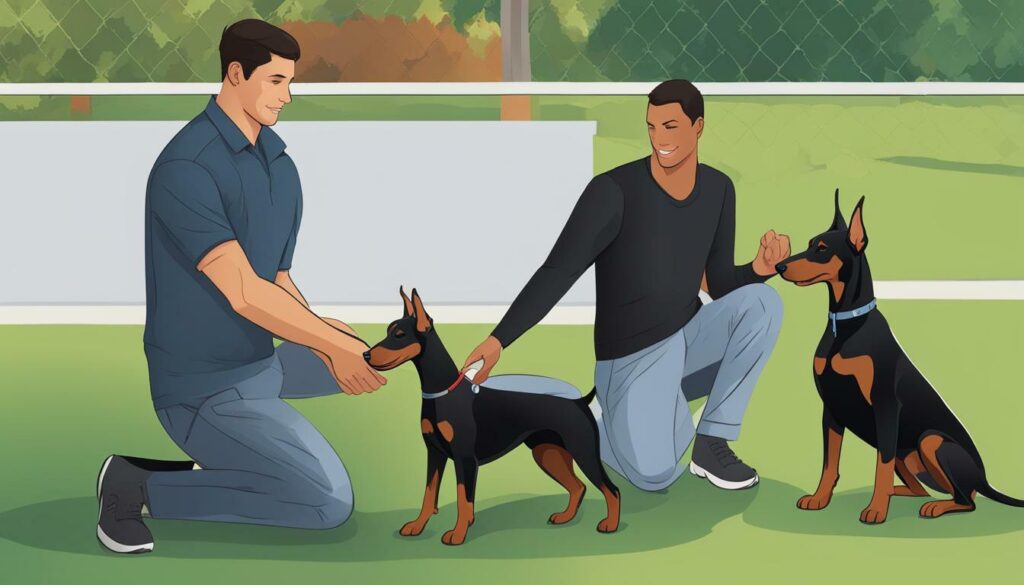
Troubleshooting and Overcoming Challenges
Every Doberman Pinscher training journey comes with its unique challenges, but with our professional training guide, you’ll be equipped to tackle them head-on and achieve lasting success. As you embark on this endeavor, it’s essential to anticipate and address potential obstacles that may arise along the way. Here are some common challenges you may encounter and tips for overcoming them:
1. Consistency and Motivation
Consistency is key when training your Doberman Pinscher. It’s important to establish clear rules and boundaries and stick to them. However, maintaining motivation can be challenging, especially when progress seems slow. To stay motivated, set realistic goals, celebrate small victories, and use positive reinforcement techniques like treats and praise to encourage your Doberman’s progress.
2. Behavioral Issues
Doberman Pinschers can exhibit behavioral issues such as aggression, separation anxiety, or excessive barking. Addressing these issues requires patience, understanding, and professional guidance. Our training guide provides effective techniques to tackle these behaviors, including desensitization exercises, counterconditioning, and redirecting unwanted behavior through positive reinforcement.
3. Distractions and Environmental Challenges
Training your Doberman in distracting environments can be challenging. To overcome this, start training in a quiet and controlled setting, gradually introducing distractions as your Doberman progresses. Use visual cues, such as hand signals, to help your dog focus on commands even in distracting situations. Additionally, ensure your training sessions are short and engaging to keep your Doberman’s attention.
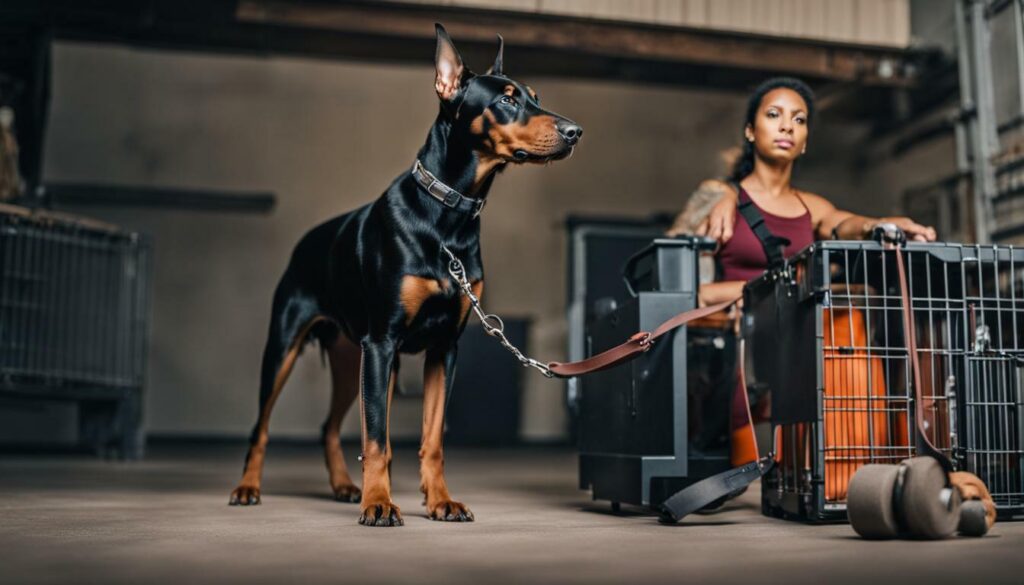
4. Time and Patience
Training a Doberman Pinscher requires time and patience. Remember that every dog learns at their own pace, and progress may not always be linear. Stay consistent, be patient with your Doberman, and focus on building a strong bond through positive reinforcement. With time and dedication, you’ll see the results of your efforts and enjoy a well-trained and happy companion.
| Common Challenges | Tips for Overcoming |
|---|---|
| Consistency and Motivation | Set clear rules and boundaries, celebrate small victories, and use positive reinforcement techniques. |
| Behavioral Issues | Address these issues with patience, understanding, and professional guidance, using techniques like desensitization and counterconditioning. |
| Distractions and Environmental Challenges | Start training in a controlled setting, gradually introduce distractions, use visual cues, and keep training sessions short and engaging. |
| Time and Patience | Stay consistent, be patient, and focus on building a strong bond through positive reinforcement. |
The Comprehensive Doberman Pinscher Training Guide
Congratulations on reaching the end of our comprehensive Doberman Pinscher Training Guide, which covers everything you need to know to raise a happy, well-trained, and obedient Doberman Pinscher. This guide is specifically tailored to the unique training requirements of Dobermans, providing techniques for obedience training, behavior training, and more.
Throughout the guide, we emphasize the importance of training for the overall well-being and happiness of your Doberman. We provide valuable tips on motivating your dog, using visual cues effectively, and maintaining consistency in your training approach.
The guide is structured in a user-friendly manner, with a table of contents to help you navigate through various topics such as leash training, crate training, potty training, and more. We also highlight the need for specific training products to enhance your training sessions with your Doberman Pinscher.
Socialization and starting training from a young age are crucial for a well-rounded Doberman. We offer advice on finding a reputable breeder or rescue organization and provide guidance on choosing the right puppy with the appropriate temperament for successful training.
From the early stages of training at 8 weeks old to the developmental milestones up to 12 months, our guide covers essential aspects such as housetraining, recall training, and impulse control. We emphasize the importance of attention training and explore various dog sports where Dobermans excel, providing options for mental and physical stimulation.
We acknowledge common mistakes made by Doberman owners and advocate for modern training methods that focus on positive reinforcement rather than dominance and force. The guide concludes by offering a comprehensive training guide that covers topics ranging from adoption and house-training to nutrition, exercise, training principles, and troubleshooting.
By following our comprehensive Doberman Pinscher Training Guide, you will be equipped with the knowledge and techniques necessary to raise a well-behaved and happy Doberman Pinscher. Good luck on your training journey and enjoy the wonderful bond you will build with your furry companion!
FAQ
What is the purpose of this Doberman Pinscher training guide?
The purpose of this guide is to provide Doberman Pinscher owners with effective techniques and strategies for training their dogs. It aims to help unlock the potential of this unique breed and promote their well-being and happiness through disciplined training.
What topics are covered in this training guide?
This training guide covers a wide range of topics, including obedience training, behavior training, leash training, crate training, potty training, and more. It also provides guidance on socialization, starting training from a young age, and troubleshooting common training challenges.
What training methods are recommended in this guide?
This guide emphasizes the use of positive reinforcement techniques as opposed to dominance and force. It focuses on modern training methods that have been proven to be effective and promote a strong bond between the owner and their Doberman Pinscher.
Are there specific products recommended for training a Doberman Pinscher?
Yes, the guide mentions the need for specific products that can aid in the training process. These may include items such as training treats, clickers, and appropriate training tools like leashes and crates.
What is the importance of socialization for Doberman Pinschers?
Socialization is crucial for Doberman Pinschers to ensure they develop appropriate behavior and can interact well with humans and other animals. This guide provides resources and tips on how to properly socialize your Doberman Pinscher for a well-rounded pet.
Does this guide cover advanced training and dog sports?
Yes, the guide explores advanced training techniques and highlights various dog sports where Doberman Pinschers excel. It provides tips for honing their skills and keeping them mentally and physically challenged.
Is this training guide suitable for all stages of a Doberman Pinscher’s life?
Yes, this guide covers the stages of training from 8 weeks to 12 months and beyond. It provides guidance for early training stages, as well as advanced training for adult Doberman Pinschers.
What makes this training guide specifically tailored for Doberman Pinscher owners?
This training guide takes into consideration the unique characteristics and training requirements of Doberman Pinschers. It provides specialized techniques and strategies that are most effective for this breed, ensuring success in training.
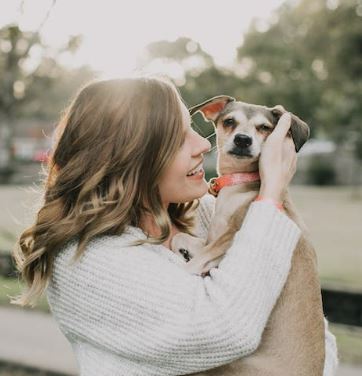
Marissa Delotta, 36, from Dayton, Ohio, is the creative force behind Roverboard.com, a beloved online destination for dog lovers. As a dedicated mom and canine enthusiast, Marissa combines her family experiences with her love for dogs to offer a platform where dog owners can exchange tips, heartwarming stories, and advice. Her website has become a vibrant community for sharing the joys of dog parenting. In her free time, Marissa enjoys exploring dog parks with her family and volunteering at local animal shelters.